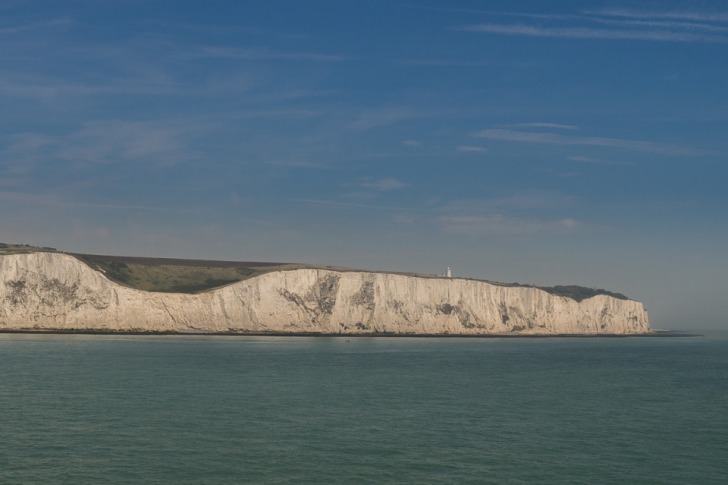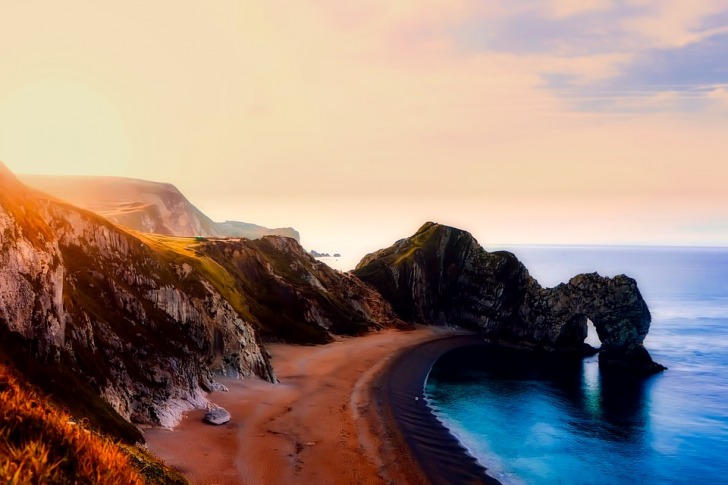There are probably many things that come to mind when you think of the English Channel — for example, the Eurotunnel, maritime trade, and marathon swims.
You probably do not think about sharks, however.
After all, sharks in the English Channel are almost never talked about.
But why is that the case?
It is probably due to the fact that there have been no reported fatal shark attacks in British waters since 1922, and there have been no fatal attacks in the English Channel — ever.
That might be surprising to you, considering the number of people that swim in the Channel’s waters.
The truth is that most sharks are harmless to humans and are not at all interested in attacking or eating them, contrary to popular belief.
Also, although sharks do exist in the English Channel, they are an extremely rare sight, possibly due to the strong currents and relatively poor visibility that characterize this body of water.
However, we have a wealth of information about these ever-elusive creatures.
And who knows?
If you ever take a trip to the English Channel, you might just be one of the lucky few that catch a glimpse of these impressive fish — right in their habitat.
Contents
So… Are There Sharks in the English Channel?
There are indeed sharks in the English Channel.
Actually, there are 21 species of sharks that call the Channel’s waters home.
These include porbeagles, blue sharks, thresher sharks, shortfin makos, and oceanic whitetips.

- Porbeagles – The muscular bodies of porbeagles, also known as salmon sharks, allow them to swim over great distances to feed and reproduce. Although they can be spotted in the English Channel, they can also be found as far off as the Pacific Ocean. That said, porbeagles in the North Atlantic tend to be larger (growing to a length of 4.9 to 6.6 feet and reaching a weight of about 300 pounds) and live shorter lives than those in the south Pacific.
- Blue sharks – Even longer than the porbeagles are the blue sharks, which can reach a length of roughly 10 feet and achieve a weight of approximately 250 pounds. Despite its impressive size, the blue shark is a lot less threatening than humans tend to think. Having derived its name from the blueish color of its skin, the blue shark has been considered an endangered species since 2016.
- Thresher sharks – Characterized by their long caudal fins, thresher sharks are also known to have distinctive-looking dorsal fins and pelvic fins. Their teeth are small and razor-sharp, making them effective predators. The diet of thresher sharks primarily consists of mackerel, squid, young tuna, bluefish, and cuttlefish. With colors ranging from brown to blue on their dorsal fins, threshers range in length from 8 feet to 25 feet. The heaviest recorded weight is 767 pounds.
- Shortfin mako sharks – The shortfin mako shark, which can grow up to 12 feet in length and weigh as much as 1,200 pounds, is widely known for its speed and athleticism. Swimming at top speeds of 45 miles per hour, this creature is the fastest shark and among the fastest fishes on Earth. But its unmatched speed is not the only thing that sets the shortfin mako shark apart. It has an impressive leaping ability, sometimes jumping to great heights during its hunting sprees.
- Oceanic whitetip sharks – Although primarily found in tropical and subtropical bodies of water, the oceanic whitetip shark has been spotted in the English Channel, a cooler body of water. A deepwater creature, this shark matures late and has a long lifespan. However, due to human overfishing, its population has significantly declined all around the globe. Since 2018, it has been listed as a threatened species under the Endangered Species Act.
Is it Safe to Swim in the English Channel?
It is absolutely safe to swim in the English Channel.
That is partly why the Channel is a high-profile venue for swimming competitions and other sporting events.
If you are looking for a fun, relaxing beach experience for your next vacation, you are in luck.
There are many picturesque beaches along the English Channel, including beaches in Normandy, Upper Normandy, Nord-Pas-de-Calais, Picardy, and Brittany.
Whether you just want to lie down and catch some sun, go scavenger hunting, swim, or even ride horses, there are plenty of things to do.
Swimming, as you already know, is one of the most popular activities in the English Channel.
And if you want to go swimming — whether casually or competitively — you are in for a treat.
That said, there are certain things you need to bear in mind.
Just like any other body of water, the English Channel can pose some risks for swimmers who are not careful.
According to the Channel Swimming & Piloting Federation (CS&PF), the biggest risks associated with swimming in the Channel are lack of training and experience, hypothermia, poor preparation, and overconfidence.
To prevent hypothermia, it is important to wear a drysuit or wetsuit while you are in the water.
Make sure you only go waist deep, but if you wish to fully submerge yourself in the water, do not stay in there for too long.
Also, avoid drinking alcohol, which can accelerate hypothermia.
If you are planning to swim competitively, make sure you train and prepare adequately.
This might sound obvious to you, but, unfortunately, swimmers have died or been seriously injured due to inadequate training/preparation and overconfidence.
The English Channel will always be there, and you should never rush into a swimming competition without doing your due diligence first.

Interesting Shark Facts in the English Channel
Shark attacks are almost nonexistent.
Although some reports say that there have been no unprovoked shark attacks in British waters, including the English Channel, since records started in 1848, this chart shows that there indeed have been unprovoked shark attacks.
That said, unprovoked attacks in the Channel are extremely rare, with the last one occurring in 1971.
Besides, shark attacks are quite rare in general.
As long as people respect these creatures and maintain a reasonable distance from them, they should be safe.
Swimmers are more likely to get stung by stingrays.
The common stingray, which can grow up to 5 feet in length, has been known to sting people who are not careful.
However, although the sting is painful, it is rarely fatal (unless the chest or abdomen is stung).
Steve Irwin was killed in 2006 when a stingray’s barb pierced his heart.
This just shows that, even though stingrays are mostly harmless to humans, you should not touch the fish, which use their barbs for self-defense.
Climate change may affect sharks in the English Channel.
The great white shark, for example, may migrate to the Channel due to rising global temperatures.
Although the great white shark is one of the most feared species on the planet, there is really nothing to be afraid of.
Yes, there have been unprovoked attacks on humans, but new studies are suggesting that great white sharks do not attack humans on purpose — but because they have poor eyesight.
Sharks are mainly saltwater-inhabiting creatures.
Salt is necessary for their survival.
Without it, their cells would cease to function, and they would just bloat and die.
Because of this salt reliance, sharks largely avoid freshwater.
Outside of their saltwater habitats, their internal salt levels would mess up and they simply would not survive.
Bull sharks, however, are a species that are known for their ability to live in freshwater environments.
Because they have the physiological adaptations necessary for survival in freshwater, they do not need to live exclusively in saltwater.
The English Channel, which is primarily a salt body of water, has no bull sharks as far as anyone is concerned.
There are, however, 21 shark species in the Channel, making up a significant part of the Channel’s rich biodiversity.
3 Safety Tips for Swimming in Shark-infested Waters
- Do a visual scan. This is one of the most important things you can do before dipping in the water. You want to make sure the water is not murky. If it is, stay out. Sharks cannot see clearly in murkiness and might mistake you for prey (e.g., a dolphin) and attack. If you do see a shark, get out of the water as soon as you can. While this might sound obvious, some swimmers have ended up in hot water (no pun intended) because they intentionally swam with sharks.
- Avoid swimming alone. If you swim with other people, sharks will be less likely to attack you. Besides power in numbers, there is also power in perceived size. A report by the International Shark Attack File says that if you appear “large” and shark them hard on their nose when being attacked, they will very likely stop.
- Keep close to shore. If you are just a casual swimmer, avoid swimming in the deep parts. Otherwise, if you get attacked or bitten by a shark, it will be much more difficult to call for help and be seen/heard.

Summary
The English Channel is famous for many things, including picturesque beaches, iconic swimming competitions, bustling maritime trade, and the world-renowned Eurotunnel.
Although the Channel is a salt body of water teeming with marine life, humans very rarely see or encounter sharks there.
There are actually 21 known species of sharks in the Channel, many of which are apex predators that play a huge role in maintaining the marine ecosystem.
These include porbeagles, blue sharks, thresher sharks, shortfin makos, and oceanic whitetips.
Unprovoked shark attacks in the Channel are extremely rare, with the last one taking place in 1971.
However, swimmers still need to be cautious when swimming in the Channel’s waters.
Unprepared swimmers have been known to develop hypothermia and/or drown in the English Channel, so it is always important to prepare accordingly, whether you are a casual or competitive swimmer.
All in all, the English Channel is extraordinarily safe for swimmers.
As long as you do your due diligence, you should be able to swim worry-free and enjoy your experience.
Sources
- https://www.nationalgeographic.co.uk/animals/2020/07/which-sharks-swim-in-uk-seas-more-than-you-might-think
- https://oceana.org/marine-life/porbeagle-shark/
- https://www.marinebio.org/species/thresher-sharks/alopias-vulpinus/
- https://oceana.org/marine-life/shortfin-mako-shark/
- https://www.fisheries.noaa.gov/species/oceanic-whitetip-shark
- http://cspf.co.uk/risks-and-responsibilities
- http://www.sharkattackdata.com/place/united_kingdom
Frequently Asked Questions
Will more sharks migrate to the English Channel?
A study has claimed that several shark species, including the great white shark, will migrate to British waters due to climate change.
These species, which mainly inhabit warm waters, will be drawn to historically cooler bodies of water, like the English Channel, because of their gradually increasing temperatures.
When was the last fatal shark attack in British waters?
The last fatal shark attack in British waters was in 1922.
This happened off the coast of Hornsea in the Caspian Sea.
There have been no recordings of fatal shark attacks in the English Channel.
Are the stingrays dangerous?
The common stingray, the largest stingray species in the English Channel, is mostly harmless to humans.
Nevertheless, it is armed with barbs, which it uses for self-defense.
If swimmers are not careful, they may get stung.
Its sting is rarely fatal, but if a person gets stung in the chest or abdomen, they should get medical attention immediately.












Hornsea is on the Yorkshire coast of the North Sea, not the Caspian Sea in Russia
Porbeagles are not the same as salmon sharks. They are two separate though closely related species and both part of the white shark family.
The English Channel is home to 21 species of sharks, including porbeagles, blue sharks, thresher sharks, shortfin makos, and oceanic whitetips.